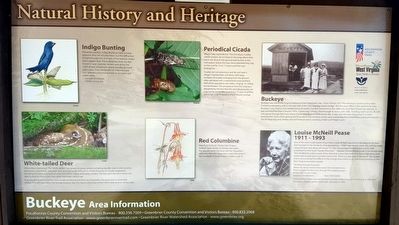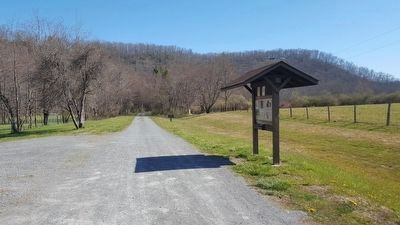Buckeye in Pocahontas County, West Virginia — The American South (Appalachia)
Natural History and Heritage
Buckeye
(Passerina cyanea) lndigo Buntings have no blue pigment; they are actually black, but the diffraction of light through the structure of the feathers makes them appear blue. These attractive birds are also found in rural roadside thickets and along the right-of-way of railroads, where woodlands meet open areas. They are beneficial to farmers and fruit growers, consuming many insect pests and weed seeds.
• Length: 4.5 inches
• Small, conical bill
White-tailed Deer
(Odocoileus virginianus) The White-tailed Deer grazes on green plants, including aquatic ones in the summer; eats acorns, beechnuts, and other nuts and corn in the fall; and in winter browses on woody vegetation, including the twigs and buds of viburnum, birch, maple, and many conifers. The four-part stomach allows the deer to feed on items that most other mammals cannot eat.
A young doe bred for the first time usually produces one fawn, but thereafter has twins and occasionally triplets if food is abundant. The female remains near the fawns, returning to feed them only once or twice a day.
Periodical Cicada
(Magicicada septendecim) The immature cicadas, called nymphs, do not feed on the twig where they hatch but drop to the ground and burrow to the root system below the tree. Once attached they stay on the root for 13 or 17 years until the next emergence.
Cicadas are not poisonous and do not have a stinger. Communities and farms with large numbers of cicadas emerging from the ground often are beset with a substantial noise problem. Half of the population are males "singing" or calling for the females. The annoyance from the singing is tempered by the fact that the periodical cicadas are only out for 4-6 weeks once every 17 years, but they can occur more frequently where broods overlap.
Red Columbine
(Aquilegia formosa) Flower May-August. Habitat Open woods, on banks, near seeps. The species name formosa, Latin for "beautiful," aptly describes this large plant, especially when it has hundreds of lovely flowers nodding over it.
Buckeye
Buckeye was one of the original stations on the Greenbrier Line. From 1914 to 1917 The American Column and Lumber Company operated a mill on the east side of the river near the station bridge. The first post office in the community, then Buckeye Cove, Virginia, was established prior to the Civil War. Sometime in the 1880's the Rush Run School was opened. lt was renamed Buckeye School in 1933. Community children filed through its doors until 1960. Traveling south on U.S. Rt. 219 one passes through Mill Point where the McNeel
gristmill now stands idle. lt was near this area that James E.A. Gibbs invented the chain-stitch sewing machine, which was certainly a time saver enjoyed by the young ladies in this photograph. The Buckeye flag stop shelter pictured here served as a waiting shelter and freight room.
Louise McNeill Pease
1911 – 1993
One of the most noted poets of our time, Louise McNeill, was born in Buckeye on the farm that has been in her family for nine generations. "Until I was sixteen years old, until the roads came, the farm was about all l knew.” In 1927 she penned her first poem and in 1939 published her first book “Gauley Mountain.” Stephen Vincent Benet wrote in his introduction, “Miss McNeill has taken a part of the American scene that most of us know little about and made both its past and its present come alive. There is a new poet in the land!” Her rooted poems documented the effects of the change from a farm to an industrial economy on the West Virginia mountain people.
”Winding through the passes
Where the dying chestnut trees reach their shriveled arms —
Thorn-crossed and time-lost, through the tangled grasses —
All the little country roads,
Searching for the farms. . .” from THE ROADS
Louise McNeill Pease was named Poet Laureate of West Virginia in 1979 and in 1985 was honored as West Virginian of the Year. She died in 1993.
Topics. This historical marker is listed in these topic lists: Animals • Arts, Letters, Music • Railroads & Streetcars.
Location. 38° 11.264′ N, 80° 7.663′ W. Marker is in Buckeye, West Virginia, in Pocahontas County. Marker is on Buckeye Station Road (County Route 219/15) half a mile east of Seneca Trail (U.S. 219), on the left when traveling east. Located along the Greenbrier River Trail. Touch for map. Marker is in this post office area: Buckeye WV 24924, United States of America. Touch for directions.
Other nearby markers. At least 8 other markers are within 4 miles of this marker, measured as the crow flies. Frank and Anna Hunter House (approx. 2.7 miles away); Welcome to Pocahontas County (approx. 2.7 miles away); Marlinton (approx. 2.9 miles away); William L. "Mudwall" Jackson (approx. 2.9 miles away); Marlinton: Heritage (approx. 3 miles away); Greenbrier Covered Bridge (approx. 3.1 miles away); Home for a Separatist Community (approx. 3.3 miles away); A Spectacular Crash! (approx. 3.4 miles away).
Credits. This page was last revised on June 16, 2016. It was originally submitted on April 17, 2016, by Bernard Fisher of Richmond, Virginia. This page has been viewed 265 times since then and 5 times this year. Photos: 1, 2. submitted on April 17, 2016, by Bernard Fisher of Richmond, Virginia.

